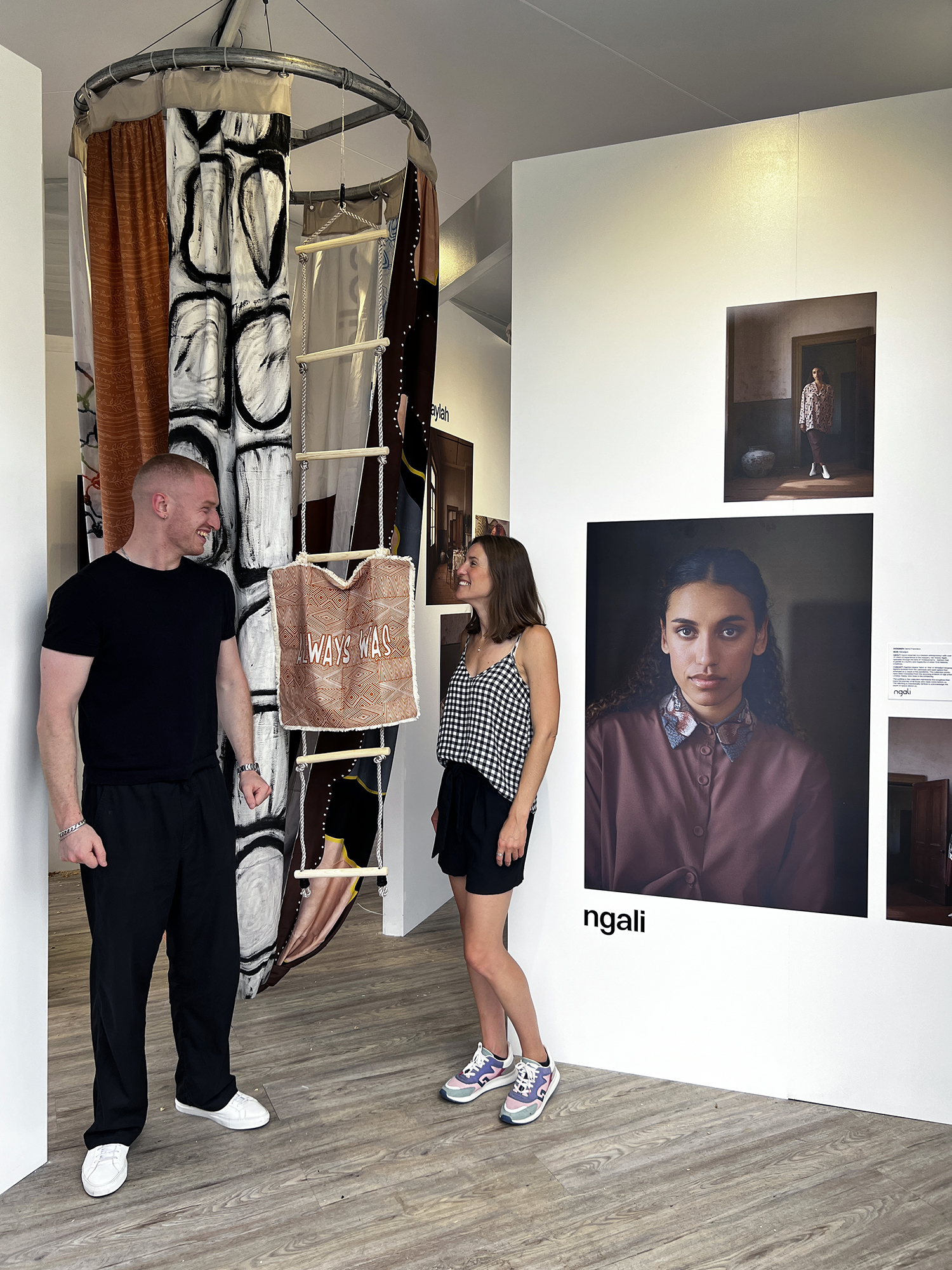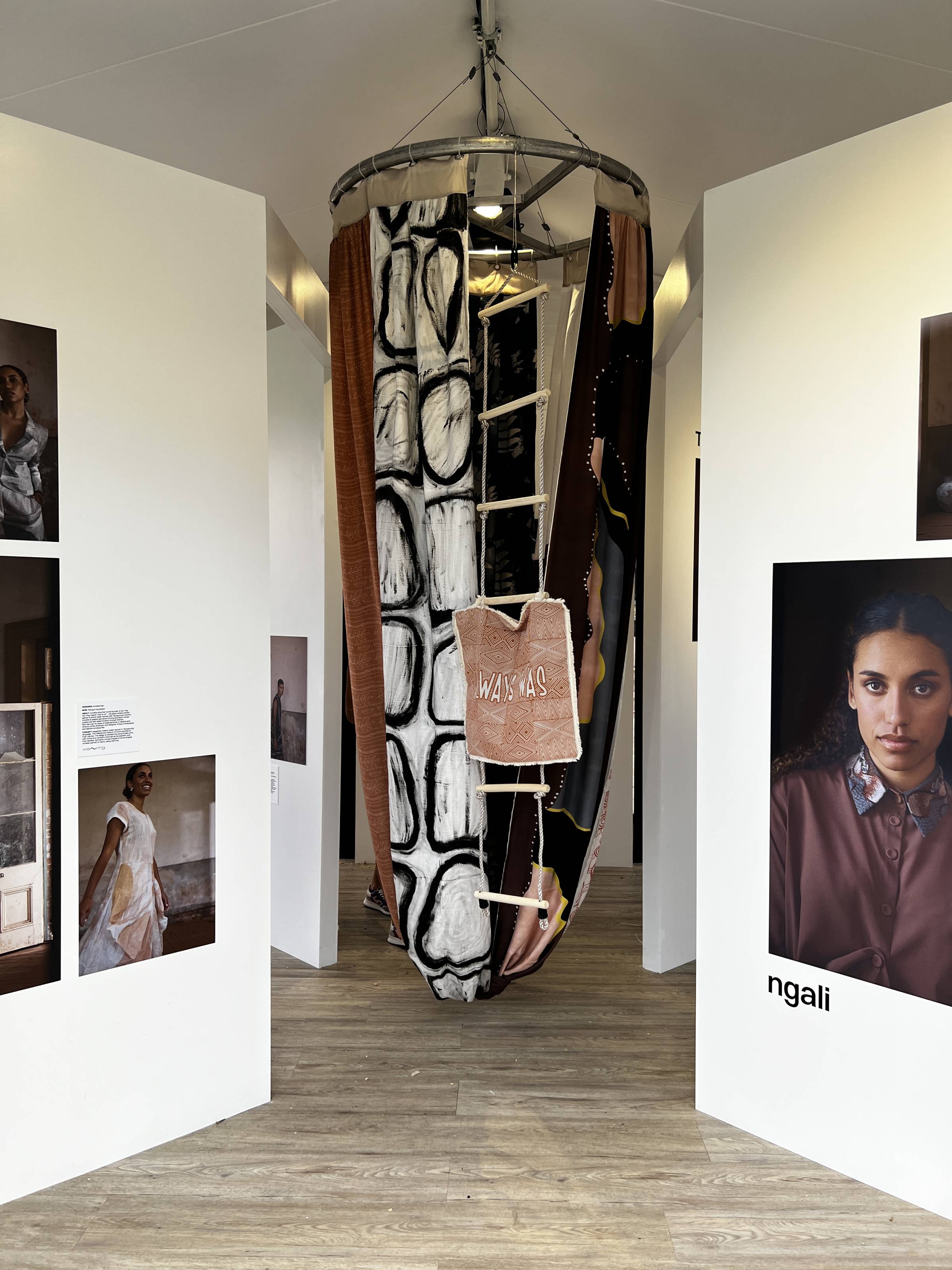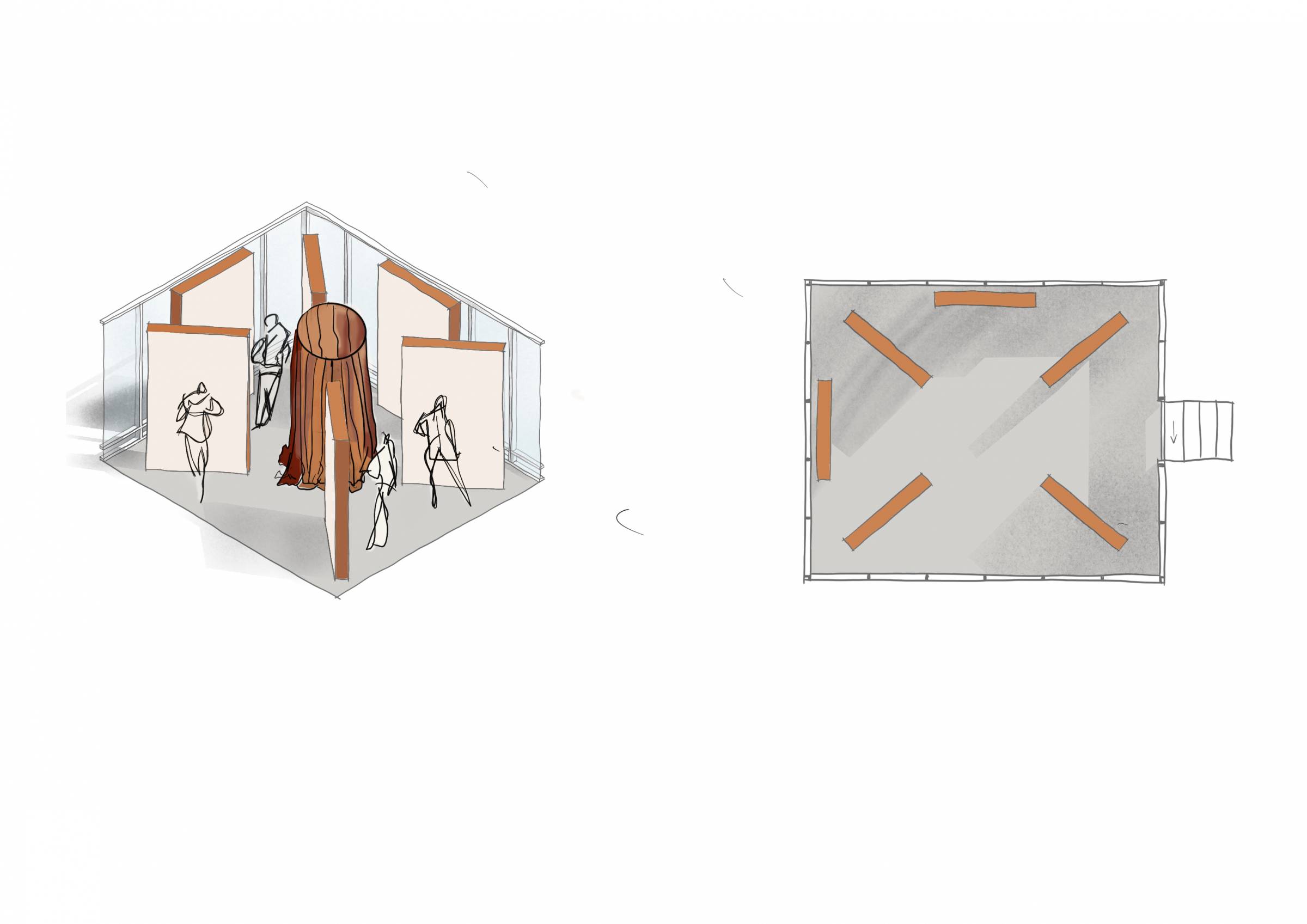The KIN Fashion Pavilion at Melbourne Fashion Festival (MFF) showcased fashion design by nine Aboriginal and Torres Strait Islanders. Talk us through the design concept of connecting to Country.
Looking at stills from the designers’ Instagram feeds, it’s clear that a connection to nature and connection to Country comes through very strongly in their fashion. Everyone’s print work, designs, styles, and supporting imagery share a common inspiration drawn from Aboriginal and Torres Strait Islander cultures.
When we met with KIN Fashion, and talked about that, they thought it was so obvious. Still, it felt unique and very special for outsiders like us. So, we picked up on it straight away and made sure it was celebrated. This starting point led us to explore particular colour palettes and think about bringing them in. It also made us think about bringing physical flora, fauna, and potentially even land into the exhibition space to give a strong visual association.
During the design process meetings with KIN Fashion they spoke about Country – specifically what Country and whose Country – it became apparent that these designers were from all over Australia, from different language groups. So the idea of the ‘quintessential Australian landscape’ was changed, and we thought more deeply about how we can create a space that addresses all of the places, not one generic place. This raised some ethical questions about if we could take particular flora or fauna or land, as there are sensitivities around that, and whether taking objects from Country was culturally appropriate.
One design brand, Clothing the Gaps– a clever play on the Government initiative to ‘Close the Gap’ – sold special edition cushions featuring a print by a First Nations artist with the words ‘Always Was’, a condensed version of the powerful, deeply important message about the fact that Australia was never ceded and so it ‘Always Was, Always Will Be Aboriginal Land’.
What’s unique about the Pavilion?
This space at the 2022 Festival is the KIN Studio’s debut to the fashion world. The key is to showcase the nine talented First Nations fashion and homewares designers to give them a launching platform that we hope brings them great career success. Some are more established than others, so to put them in front of the public on a high-profile stage feels like this is a major milestone.
As well as showing off this year’s cohort, the Pavilion’s aim is to speak to new First Nations designers to hopefully attract more great design talent to the program in future years.
Visitors had the exciting opportunity to understand more about what constitutes First Nations fashion through these individual designers and their take on presentation, colours, textures and overall statement.

The fabric centrepiece is a clever fashion tie in. How did that come about?
We all spoke a lot about the importance of a central unifying element early in the design process. You know, a big statement that’s visible from the outside to attract people into the space. You have to be bold to stand out amongst the crowd at a fashion festival. So, it’s a bonus that this display of connecting to Country doubled as a lovely selfie moment and added extra pizzazz to the Pavilion.
We knew that the centrepiece needed to connect all the designers – to unify their display walls. This is where we started thinking about using native flora and fauna and how to do that in the most strikingly beautiful way. However, due to some of the challenges around integrating beautiful flora/fauna/land, we decided to go with the fashion side of things and gave each designer a set amount of fabric to design something personal to represent their collection.
We thought about this as a totem of sorts to represent the nine designers. It was to start in their display space and come together in the centre of the room to form a ring that you would walk underneath. To prevent it from being damaged, it ended up being a closed circle in the centre. As the fabric is tactile, people could feel it as they move around it to enhance their experience of the space.
Being a fashion festival, the concept of tactility came up a lot in our briefings. We had an idea to get people immersed in a large sewing circle to create an ambience inside the Pavilion, but unfortunately, space didn’t allow this to manifest.
When you think about it, fashion can be perhaps a little bit intimidating – with all those perfect models on the catwalk – so our concept was to remove any perceived barriers and bring people into that centre, then bring all the designers together, which created an impactful synergy.
Sustainability is something we’re keenly aware of, especially working on a temporary structure that’s only used for a week. So, we made sure that as many elements as possible could be reused. There’s talk about the display images being used in Sydney and potentially London and the walls being set up in KIN’s Melbourne office for ongoing exhibitions.
The Pavilion appeals to all the senses, not only sight; what are the sensory interior design features?
The whole idea was to do as much as possible within a short time to create a sense of Country in the middle of the city.
Along with tactility, our initial conversations focused on making the environment as immersive as possible to transport visitors to different places around Australia through their senses. Sound is a big one. There was a screen showing interview content with the resident designers. Obviously, the visual elements were taken care of with the gorgeous displays. And there were discussions around bringing in flora and fauna to complement and style space on top of the fabric. Smell is a sense that was more challenging to address. Inspired by the scent element in the Van Gogh exhibition, we wanted to weave that idea in, but it wasn’t practical with the timeframe and budget.
Working in the fashion space for this project was a wonderful experience. We got to explore the softer side of design that really plays on human emotions and emphasises connections between people and space in different ways, which architecture doesn’t always get to do.
Did you conjure any design concepts that couldn’t be used on this occasion?
Yes, rocks! The big one was our starting point of looking at the flora, fauna and Country and bringing these things tangibly into the space. After some initial reluctance about removing land from Country and whether that was the right thing to do, everyone decided it would be a ‘wow’ moment. We were quite keen to pursue the idea of getting a large rock, a collection of smaller rocks, or red earth into the Pavilion. Purely from a visual, photographic mindset, that would have been stunning. Especially if dramatically lit, it would be a powerful idea. However, the more practical considerations got in the way. Where would it come from? How would we get it in time and get permission from the land’s Traditional Owners? There were also structural concerns about having a large rock on an elevated platform.
We had the idea of getting field recordings from out in the bush and playing that throughout the Pavilion.
Another idea was to have the exhibition bleed out into the public space; extend the installation beyond the Pavilion to draw people in, frame the entrance and give it more power from outside. But, unfortunately, I think the budget may have gotten the better of us on this one.
A few different tests were done on how the walls would form and shape the space. We found that perfect balance between comfortable circulation for visitors and giving the designers enough wall space and – importantly – an equal amount of wall.
The final idea was to have the designers’ different language groups represented graphically. The idea was for a continuous thread to wrap around the bottom of the walls to show their unique standpoints while bringing them together. As you can see, unity was a core idea.
Any parting thoughts?
We have all deeply enjoyed this opportunity to engage with the First Nations community members on a creative project. For me (Catherine), as a Kiwi, I’m still on my journey of understanding First Nations cultures in Australia, so working in this way with people from the community was a great learning boost. It was a real privilege to be a part of this new initiative with the passionate KIN team and I’m excited to see KIN Fashion evolve going forward.
And for me (Evan), I felt very lucky during the entire process. Last year, a significant part of my Honors thesis was researching and getting involved in cool burning practices on Taungurung and Yorta Yorta land. Being able to continue to work with First Nations people like this in a big professional practice is a fantastic opportunity. It has been excellent to take the knowledge out of an institutional space, bring it into a professional place, and have such a promising output.






